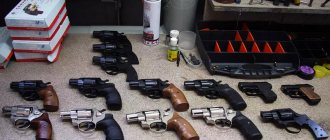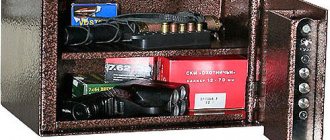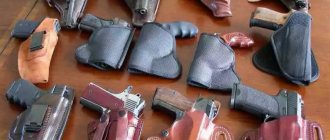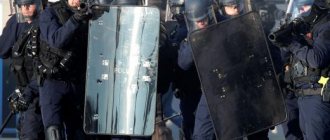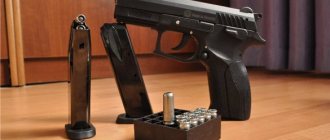Illegal arms trafficking is considered one of the most profitable types of criminal business, the income of which is comparable to income from drug trafficking. The law prohibits the sale of weapons, transfer and exchange of them without going through a certain state procedure, and the possession of weapons without a license is also prohibited. Illegal acquisition and storage of weapons is an independent crime, but almost always it is only part of others - robbery, kidnapping, hostage-taking, murder. You can read about the features of bringing to criminal liability for violation of the law “On Weapons” in this article.
Illegal arms trafficking is a criminal offense
First, let’s figure out what “turnover” is? These are all types of activities associated with the use of a certain type of weapon, including import into the Russian Federation and export from the country. The modern Criminal Code of the Russian Federation provides for several articles (222-226.1), which provide for punishment for illegal actions involving the use of various weapon models, ammunition, and explosives. We list the actions that are considered criminal offenses:
- illegal possession;
- illegal acquisition;
- illegal transfer;
- illegal production;
- illegal carrying;
- illegal sales;
- illegal transportation;
- theft.
In addition, individual officials may bear administrative responsibility for incorrect registration or unreasonable issuance of a license to store/carry a hunting rifle, limited destruction weapon, etc.
In a number of cases, administrative liability can be applied to citizens - here a lot depends on the type of weapon, that is, the subject of the act.
Typology
It is a license issued by the Internal Affairs Authority at the place of residence. There is an established opinion regarding the correct transportation of products in this category. And many police officers adhere to it. Thus, it is considered correct to carry bladed weapons along with accompanying documents in a bag or backpack. At the same time, of course, when detained by police, one can try to explain that the knife in the case on the belt is not a means of self-defense and is hanging solely for convenience. Moreover, the law does not stipulate where exactly it should be kept during transportation. Of course, you should have the relevant documents with you. Otherwise, it will be difficult to prove anything.
Transportation procedure
In the 70s of the previous century, ordinary citizens were forced to look for means to ensure their safety while on city streets. This was due to a sharp increase in crime. Over the next decade, the volume of manufactured bladed weapons for concealed carry increased significantly. Initially, manufacturers took as a basis the developments of the above USS and USO. Subsequent improvements in the designs of bladed weapons for concealed carry followed the development and implementation of new devices, reducing the size of the blade itself while simultaneously increasing its cutting or piercing properties. Products disguised as ordinary objects were also produced.
More to read —> Making a will for individuals
Currently, in order to obtain a license to store and carry bladed weapons, you do not need to be a superman. You just need to come to the government agency that has the right to issue such permits, write an application, pay a small state fee of no more than two thousand rubles and undergo a short medical examination. Then wait a little time and get the finished paper in your hands. With it, a person will not receive any punishment and will own bladed weapons legally. Therefore, you should not risk your money, time, and maybe even freedom, but you should do everything according to the law and obtain the appropriate permission, and then purchase the edged weapon you like.
In this article you learned about carrying knives. If you have any questions or problems that require the participation of lawyers, then you can seek help from the specialists of the Sherlock information and legal portal. Just leave a request on our website and our lawyers will call you back.
What is not considered a bladed weapon?
Criminal liability awaits those who illegally sell bladed weapons. The Criminal Code of the Russian Federation, and in particular Article 222, part four, states that for the sale of edged weapons, any person will be punished in the form of:
According to GOST, a sharpened knife should cut a birch branch with a thickness of 10-12 mm with a humidity of about 12% 5-6 times, leaving a smooth, burr-free cut. Law enforcement agencies tend to define sharpening of a knife as simply removing the cutting edge.
Subject of the crime under Art. 222-226.1 of the Criminal Code of the Russian Federation
In accordance with Federal Law No. 150-FZ, weapons in general are understood as devices and objects that are structurally designed to hit a living or other target or send signals.
Criminal liability may arise for illegal trafficking of the following weapons:
- Firearm: that is, intended for mechanical destruction at a distance by thrown equipment that receives directional movement due to the energy of a powder or other charge. Its main parts: barrel, bolt, drum, frame, receiver. In relation to the articles regulating liability for illegal trafficking of weapons on the territory of the Russian Federation, firearms are understood to mean all types:
- combat;
- official;
- civilian weapons (including homemade units). Examples include rifles, machine guns, grenade launchers, mortars, sporting or hunting rifles, revolvers, pistols, carbines, etc. At the same time, the size of the caliber does not affect the prosecution - according to criminal law, this sign is not important for the application of one or another article from the chapter of the Criminal Code of the Russian Federation.
- Self-defense weapons - that is, long-barreled smoothbore firearms, gas or traumatic ones. The legislation provides for special conditions for liability (it is somewhat milder) for its illegal storage, transportation, sale, etc.
- Ammunition: These are weapons and projectile equipment that are used to hit a target and are characterized by explosive, projectile, pyrotechnic or expulsion force. Typically, ammunition includes mines, explosive shells, grenades, as well as cartridges for any firearm.
- Explosives are mixtures of substances that explode without access to oxygen and can quickly self-propagate due to a certain chemical reaction (TNT, plastics, gunpowder). Explosive devices are those devices that initiate an explosion (for example, a fuse, a detonator).
- Melee weapons are bladed (saber, combat knife, dagger), piercing (spear, bayonet), impact (brass knuckles), and mechanical (crossbow).
The investigative authorities determine the general characteristics of the subject of the crime according to the Federal Law “On Weapons” - the basic law that defines the terms, delimitation and purpose, and also provides the basic criteria for identifying weapons. More detailed features - appearance, functionality, caliber, type of weapon and its parts can only be determined by an expert. Therefore, in criminal cases of this category, a technical and forensic examination is always carried out, within the framework of which experts conduct a study of all characterizing features, including suitability.
In the criminal legal sense, under no circumstances can the following be recognized as weapons:
- pneumatics;
- starting, signal pistols and revolvers;
- construction and installation guns;
- electric stun guns;
- household (kitchen, cutting) knives;
- signal cartridges;
- pyrotechnics.
If a person commits any crime using the listed means, his actions can be qualified under the relevant article of the Criminal Code of the Russian Federation with the attribute “using objects as weapons.”
Most often, such a qualifying feature, which toughens the punishment, may occur when committing murder, hooliganism, causing bodily harm, or robbery.
Example No. 1 .
Mironov K.R. and Pavlov A.D. attacked a saleswoman at a night stall and, threatening her with a knife, stole the proceeds. The criminals were detained, a knife was confiscated from them, and a technical and forensic examination was carried out. The expert concluded that the seized knife was not a weapon and was a household item. Thus, the charge against Mironov and Pavlov under Art. 222 of the Criminal Code of the Russian Federation was not presented, but they were punished for committing robbery with the use of an object (knife) used as a weapon.
Rules for obtaining a gas weapon permit. Is this license required?
Gas weapons are one of the most popular means of self-defense. Many citizens would like to purchase it to ensure personal safety. The only question that stops is whether it is necessary to obtain a license to carry, store and purchase such an item?
We learn more about the rules for obtaining a gas weapon and the correct execution of the necessary documents from the text of the article.
What is it and is it needed?
In accordance with the Federal Law of the Russian Federation “On Weapons,” a gas weapon is understood as an item that is used in weapons. Its main goal is to temporarily defeat the “enemy.” The pistol uses a cartridge that, due to its structure, cannot cause death to surrounding people.
The bullets are loaded with substances that have an irritating or tear-producing effect. Carrying such a weapon allows its owner to feel protected and also be able to exercise competent self-defense.
In accordance with Article 13 of the Federal Law “On Weapons”, a gas pistol in Russia must be licensed.
The license itself looks like a small laminated card . This is a kind of form on which a barely visible pattern is applied.
- The name of the document, as well as its number, is indicated at the top.
- A 3 by 4 photo is pasted to the left.
- On the right side the surname, name and patronymic of the citizen are indicated.
- The place of registration is established.
- The form is stamped by the authority that issued the license. The seal should be blue, partly on the photo, and partly on personal data.
Most often, such a card is laminated in order to maintain its original appearance longer.
A sample license is shown in the photo:
Who issues, on what basis and for what period?
Responsibility for issuing a license lies with the so-called LROs.
These are licensing and permitting departments. You can find out where they are at your local police station. To do this, you need to go to the department at your place of registration or residence. The staff will provide you with comprehensive information about where to apply, as well as what package of documents you need. And the process of further registration of weapons is carried out in the authorized executive body of the city or settlement where the citizen lives.
The license will be valid for 5 years. It extends its effect not only to the fact of acquiring weapons, but also to storing and carrying them.
The legislative framework
Requirements
An individual who applies for a license must meet a number of requirements:
- Coming of age.
- Availability of a medical report stating the absence of any contraindications to interaction with weapons.
- No convictions for intentional crimes.
- There is no repeat administrative offense.
- Permanent place of residence.
- Availability of a provided and correctly completed license application.
- Providing all listed documents.
- There are no diseases that are a direct contraindication to having a weapon. Among them:
- addiction;
- alcoholism;
- mental disorders.
Medical examination and obtaining a certificate
A medical certificate for a weapon is a guarantee of legality. The legal basis for issuing this document is Order 441, which was issued by the Ministry of Health in 2021. The certificate is issued only to adults.
Who can be involved
For the commission of most crimes that are covered by the concept of “illegal trafficking in weapons,” any person over 16 years of age can be held accountable. Teenagers over 14 years of age may also be charged for some crimes in this area:
- if the actions are related to the illegal trafficking of explosive devices or explosives, including their production (that is, Articles 222.1, 223.1 of the Criminal Code of the Russian Federation);
- if the actions are related to the theft or extortion of any weapons or ammunition.
As for judicial practice, sentences against minors under Art. Art. 222-226 of the Criminal Code of the Russian Federation are issued quite rarely.
Officials whose work is related to issuing a license, destroying cartridges, etc., can only bear administrative liability for violations committed in their activities.
Administrative responsibility
Article 20.8 of the Code of Administrative Offenses of the Russian Federation provides for the responsibility of officials and legal entities for:
- violation of the requirements of the law on the production, sale, destruction or accounting of weapons and ammunition for them (punishment - a fine of up to 500,000 rubles);
- significant violation of licensing requirements in the production of defense items (punishment - disqualification of officials for up to one year, suspension of the work of a legal entity for up to 60 days);
- violation of the procedure for issuing confirmation of completion of training, testing knowledge of safe handling of weapons or a medical permit to carry and store (punishment - disqualification of officials for up to one year, a fine of up to 50,000 rubles).
Most often, according to Art. 20.8 of the Code of Administrative Offenses of the Russian Federation, employees of gun stores are hired where citizens can make a purchase. These organizations operate strictly under a license; any violation of the procedure for the sale, accounting or storage of weapons or ammunition entails quite harsh measures. Also, often the objects of inspection by law enforcement agencies are medical organizations that offer services for issuing commission opinions on the health status of the future owner of the gun.
But not only officials or legal entities can be prosecuted under the Code of Administrative Offenses of the Russian Federation for violations related to the circulation of weapons. The same article (parts 4-6) also provides for the responsibility of citizens for:
- violation of the rules of storage, carrying or destruction - should not be confused with illegal storage, carrying, etc. Violations of the rules of storage or carrying may consist, for example, in the absence of a safe in the house at all or in the absence of a locking device in it. At the same time, the gun, stored with such violations of the law, was purchased in accordance with all the rules and with permission;
- carrying a weapon by a person who is intoxicated (alcohol or drugs). For liability under this norm of the Code of Administrative Offenses of the Russian Federation, the fact of the citizen’s consumption of alcoholic beverages or prohibited narcotic (psychotropic) substances must be established, and a medical examination must be carried out;
- a similar offense for refusing to undergo examination;
- offenses related to gun collecting regulations;
- Illegal trafficking of traumatic or firearms smooth-bore long-barreled weapons - acquisition, storage, carrying, transfer, transportation, sale (other forms of sales and manufacturing entail criminal liability).
Punishment that may be imposed on individuals under Art. 20.8 of the Code of Administrative Offenses of the Russian Federation, varies from 500 rubles (for a regular violation of storage rules) to confiscation of the subject of the offense (a gun) and arrest for 15 days (for example, for the illegal sale of an LLC). A legal entity for similar actions may be subject to a fine of up to half a million rubles.
In practice, there are cases when a person’s actions contain both signs of an administrative offense and a criminal offense.
Example No. 2 . Nosov N.G. actually took over the inheritance after the death of his father and settled in his house. Later, he registered the house in his name, receiving a certificate of inheritance. A few years later, he discovered his father’s gun in the attic of the house, for which there were no documents. Nosov N.G. I did not apply for a license because I found the bureaucratic procedure of contacting the licensing department too time-consuming and expensive. When the fact of storage was revealed, in relation to Nosov N.G. a criminal case was initiated under Art. 222 of the Criminal Code of the Russian Federation for illegal possession of weapons, which was subsequently terminated due to the presence in Nosov’s actions only of an administrative offense provided for in Part 6 of Art. 20.8 of the Code of Administrative Offenses of the Russian Federation (illegal acquisition and storage of civilian firearms smoothbore), he was given a fine of 5,000 rubles with confiscation of the hunting rifle.
The example shows that objectively, Nosov’s actions contain signs of illegal storage within the meaning of Art. 222 of the Criminal Code of the Russian Federation and within the meaning of Part 6 of Art. 20.8 Code of Administrative Offenses of the Russian Federation. Administrative law applies.
Definition
You can carry knives. Penalties for carrying knives were abolished in 2004. In Russia, there is administrative responsibility for illegally carrying bladed weapons. Now, for violation of the rules for storing or carrying edged weapons, only administrative liability is possible
More to read —> How long is a cadastral passport valid for a room when selling
Administrative
- blade length - more than 9 centimeters;
- blade thickness - more than 0.24 centimeters;
- the contact angle between the butt and the blade is up to 70 degrees;
- deviation during transverse bending - 0.9 centimeters;
- steel hardness - 25 Rockwell minimum;
- penetration depth - more than 2 centimeters;
- There is a finger stop.
Anyone can obtain a license to carry chemical weapons. Provided that the citizen is not registered in a psychoneurological or drug treatment institution. A license is also issued to paramilitary organizations for a period of 5 years. A license is not required for sporting weapons. The law defines the circle of persons who have the right to carry bladed weapons:
Qualification under Article 222 of the Criminal Code of the Russian Federation
Let's consider the types of crimes related to illegal trafficking in weapons, ammunition and explosives, which are contained in Art. 222 of the Criminal Code of the Russian Federation.
Illegal acquisition of weapons
These are any actions aimed at obtaining weapons without complying with the rules established by the federal legislation of the Russian Federation: purchase, exchange for any value, receipt as a gift, in payment of a debt, etc.
A discovery can also be considered an illegal acquisition. There are cases when teenagers find weapons abandoned (or hidden) by someone in abandoned garages or houses. According to the legislation of the Russian Federation, you should immediately report this to the police, otherwise the finder faces criminal liability.
Often, illegal acquisition can occur when a weapon is taken possession of during the commission of a crime - then the person’s actions can also be qualified under Art. 222 of the Criminal Code of the Russian Federation and at the same time under another article of the Criminal Code of the Russian Federation, the characteristics of which fall under the main act.
Example No. 3 . The leader of an organized group “gave the task” to his subordinates to eliminate a criminal competitor by killing him. To do this, he supplied two of his assistants with two revolvers, allowing them to remain for themselves after completing the task. On the same day, the order was carried out: one of the authorities of the underworld was shot at point-blank range. When both deputies were apprehended, they were charged with both murder and illegal acquisition of revolvers.
Illegal possession of weapons
According to the meaning of the law, we are talking about placing weapons in special hiding places, hiding places, any premises where it is possible to ensure safety.
Most often, illegal storage can be expressed in the form of inaction, when a person does not specifically look for a place to leave a gun, but simply keeps it in the room where he is (at home, at work, buildings, etc.). If a weapon is concealed, camouflaged, or a certain area of terrain or part of real estate is adapted for it (a cache is specially created), then this will already be considered an active action.
Illegal possession can only occur in situations where there is no permission to keep a gun. This type of crime should not be confused (which, unfortunately, occurs in practice) with a violation of the rules for registering weapons in connection with moving to a new place of residence - only administrative liability is provided for this, nothing more.
If a person temporarily owns a gun without permission, but intends to sell it in the near future (donate it, exchange it, etc.), then his actions will only contain signs of an attempted sale. There will be no other signs (including illegal storage of weapons and ammunition) in such a situation.
Let us note that liability for the legal but careless storage of a gun is provided for separately in Article 224 of the Criminal Code of the Russian Federation. A person can be held accountable for this crime only if failure to comply with storage rules resulted in the death of a person or dangerous consequences in the form of injury or other serious consequences.
Example No. 4 . Lipatov K.E. he kept a hunting rifle at home according to all the rules: in a safe, which was installed in a place hidden from household members (in the pantry), he hid the keys to the safe in a hiding place. After another visit to him by the local police commissioner, during which he opened his safe with a key, showed the contents, and presented the gun for inspection, Lipatov closed the safe, but left the keys in the lock. Lipatov’s son, a 14-year-old teenager, took advantage of his forgetfulness and decided to show off to his peers. He got a gun while his father was away and brought it to school. When some guys examined the brought gun, others began to snatch it out of curiosity, a shot rang out - one of those present was hit by a bullet in the abdomen, which was later determined by experts to be serious harm to health. Lipatov K.E. suffered punishment under Art. 224 of the Criminal Code of the Russian Federation - he was assigned restriction of freedom.
Weapons sales
This is the irrevocable transfer of the subject of a crime to another person, both gratuitous and compensated.
This is a sale, donation, provision on debt, exchange, etc. It does not matter whether the trafficker legally owns the gun or previously acquired and possessed it illegally. In any case, the transfer of ownership of restricted items without following a certain procedure is prohibited by law. In turn, the person who bought the gun may be held liable under the same Article 222 of the Criminal Code of the Russian Federation for illegal acquisition and storage.
Actions cannot be recognized as sales in the following situations:
- during the pursuit, the suspect threw a pistol into the river - there are no signs of alienation in the criminal legal sense, we can only talk about liability for illegal acquisition and (or) storage;
- a citizen temporarily left an illegally acquired gun or ammunition in a friend’s house - there is no sign of “irretrievability”, therefore there are no signs of sale, even if the owner of the residential premises knew about the illegality of the acquisition.
Broadcast
When transferring a weapon, it is not transferred forever, but temporarily. In this case, it may simply be in the hiding place of another person, or permission may be agreed to use the object of the crime for a certain period, after which it is expected to be returned to the owner (see the above example, when the gun was left at a friend’s house for storage).
Illegal carrying of weapons
Carrying – when a person carries an illegally acquired gun, components, ammunition on his person (in clothes), in a bag, etc. If the movement occurs not with one’s person, but by means of transport (it does not matter who owns the vehicle), then the actions of the culprit may be recognized as illegal transportation of weapons.
In some situations, a legal dispute arises about qualifications when the subject of a crime is transported in a car and on one’s person at the same time.
Example No. 5 . Karpov E.N. carried an illegally acquired pistol in a holster on his belt, which he used for threats and blackmail on the orders of the gang leader. Since Karpov spent a long time traveling, he was detained by traffic police officers on the way to a neighboring region; the investigator classified his actions as illegal transportation of a seized pistol. The court did not agree with this qualification and, referring to the explanations of the Supreme Court of the Russian Federation, recognized that Karpov had a pistol on him (in a holster) as illegally carrying, despite the fact that he actually transported it in the car. The court motivated its decision by the fact that Karpov’s intent to transport the subject of the crime from one point to another was not established; the car was used for other purposes.
The practice also considered the question of whether illegal carrying would occur in the case where the same person moves between rooms of the same apartment with a weapon. Court decisions in such cases indicate a lack of intent to move weapons; the actions of the accused in such situations should be qualified as illegal possession.
All of the above actions in relation to explosive devices and explosives are qualified under Art. 222.1 of the Criminal Code of the Russian Federation.
We remind the reader that liability for the circulation of self-defense weapons occurs only in the event of their sale (Part 4 of Article 222 of the Criminal Code of the Russian Federation), while illegal storage, acquisition, transfer, carrying entails only administrative liability (Article 20.8 of the Code of Administrative Offenses of the Russian Federation).
Of course, in the work of law enforcement agencies, many controversial situations arise when investigators and judges are forced to turn to judicial practice in cases of the category under consideration. For example, will a person illegally possess a defective firearm be subject to criminal liability? Not always: the answer depends on the specific circumstances of the case. So, if a gun cannot be used for its intended purpose due to a technical malfunction, but contains serviceable parts and there were intentions to repair it, criminal liability may still arise. Otherwise, the person will not be charged with committing a criminal offense - for example, when the cartridges (that is, ammunition) are found by examination to be completely unfit for use.
Defining features of edged weapons
When carrying a weapon, it is attached to the owner’s belt and can be used immediately for its intended purpose. When transporting , the knife or dagger is in a bag or backpack and cannot be used immediately.
Permit, license or certificate?
It is necessary to clearly distinguish the concepts of “edged weapons” according to their design features and the fact of illegal use. In criminal procedural practice, a bladed weapon can be recognized as any object with which bodily injuries were inflicted using only the muscular strength of a person (like any massive blunt object, for example, the handle of a pistol, or a cutting knife for household use).
If controversial situations arise, a criminal or independent certified examination is carried out. This event will completely resolve disputes regarding the determination of the presence of distinctive characteristics inherent in coldweed.
Buying edged weapons is not prohibited by law; the range of goods offered is varied and diverse. Here it is important to understand how exactly these devices differ from other types of similar items.
Peculiarities
The right to purchase and further use edged weapons is not given to every citizen of our country who wishes to do so. These citizens must already have a special permit for storing and carrying a specific type of weapon. When making a purchase, you must make a note about this purchase in the owner’s permit document.
18 Apr 2021 uristgd 229
Share this post
- Related Posts
- Receiving an inheritance under a will in another city
- Is it possible to re-file a police report?
- Response to the Resolution on Enforcement Proceedings Sample
- Sample Characteristics for Adoption
Punishment under Art. 222 of the Criminal Code of the Russian Federation
The severity of the imposed punishment for illegal storage, acquisition, carrying, etc. actions provided for in Art. 222 of the Criminal Code of the Russian Federation, depends on the circumstances of the case, mitigating and aggravating circumstances, the presence of previous convictions and the consequences of the crime. The punishment is imposed within the following limits:
- from 2 months to 4 years of imprisonment, up to 3 years of restriction of freedom; an additional fine of 80,000 rubles may be charged for a “simple” crime, without additional characteristics (only illegal storage, transfer, sale, transportation or carrying of weapons, their main parts, ammunition);
- from 2 to 6 years of imprisonment with a fine of up to 100,000 rubles - for the same actions committed by a group of persons by agreement among themselves;
- from 5 to 8 years of imprisonment with a fine of up to 200,000 rubles - if the crime was committed as part of an organized group.
- compulsory work for up to 480 hours, correctional labor for up to 2 years, restriction of freedom for up to 2 years, imprisonment for up to 2 years, as an additional punishment a fine of up to 80,000 rubles may be imposed for the illegal sale of LLC , as well as gas, cold steel, throwing weapons.
Approximately the same punishment is provided for illegal trafficking in explosives or explosive devices in Article 222.1 of the Criminal Code of the Russian Federation. Depending on additional characteristics, it can range from 2 months to 12 years in prison.
Manufacturing
Weapons production in Russia is the prerogative of state and private paramilitary enterprises, whose control is so strict that almost every gram of raw materials used for cartridges and components is subject to counting. The Supreme Court of the Russian Federation, in a resolution of the Plenum of March 12, 2002, stipulates in a separate paragraph that relations between paramilitary enterprises in production and supply, subject to the Law “On Weapons,” do not entail any liability.
Production in artisanal conditions, without control and without a special license is criminally punishable; liability for this is provided for in a separate article 223 of the Criminal Code of the Russian Federation, which prohibits three possible actions:
- direct manufacturing, that is, creation - for example, when one weapon is assembled from components of different types of weapons - it may look completely different from the models whose parts were used;
- alteration - for example, when a firearm is produced from a flare gun, an air pistol or a sports weapon, which falls under the characteristics of a civilian weapon, that is, prohibited in circulation without a special permit. The appearance of the converted item is almost completely preserved, but the functions change;
- repair - when a faulty gun is repaired, as a result of which it becomes possible to use it to hit a target.
Punishment for such actions can reach up to 8 years in prison. In cases where the subject of the crime is a weapon of limited destruction (traumatic) or gas, the punishment is milder - up to 2 years in prison.
Article 223.1 of the Criminal Code of the Russian Federation provides for liability for the illegal manufacture (as well as alteration, repair) of explosive devices; punishment can be imposed for a term of up to 12 years in prison with an additional fine of up to 500,000 rubles.
Weapon theft
There are quite a few options for places where weapons can be stolen:
- from citizens;
- in educational organizations that have a license to accept knowledge in handling weapons;
- in hunting organizations;
- from military warehouses;
- from law enforcement weapon rooms, etc.
Responsibility for the theft of weapons and ammunition (as well as for their extortion) comes under Art. 226 of the Criminal Code of the Russian Federation and can become the basis for imposing a severe punishment of up to 15 years in prison. For qualification purposes, it does not matter from whom the gun or pistol was stolen - even if the owner also bought it second-hand, violating the law. If only the components of explosive devices are stolen (fuse, fuse, etc.), then the perpetrator is also liable for theft under Art. 226 of the Criminal Code of the Russian Federation.
In addition, it does not matter how the thief planned to dispose of the stolen items: sell, appropriate, use for their intended purpose, etc. – from the moment of illegal possession, a crime under Art. 226 of the Criminal Code of the Russian Federation is considered completed.
Anyone who, after taking possession, destroys the stolen item cannot avoid responsibility.
Example No. 6 . A military weapon, an assault rifle, was stolen from a military warehouse. The next day it became known that the warehouse security guard was guilty of this, conspiring with an organized group that carried out attacks. Having stolen the machine gun, the security guard handed it over to P.R. Belov, who that same night with his accomplices attacked the jewelry store. All those involved in the crime were soon detained and confessed to everything, including theft from the warehouse, while the detainees did not deny joint participation in the criminal plan, both in the abduction and joint participation in the robbery. The investigator established that the weapon was destroyed after the raid on the store - it was burned. However, the verdict took place against all participants, both in terms of the charge of robbery and in terms of the charge under Art. 226 of the Criminal Code of the Russian Federation.
In the case when a weapon unsuitable for use is stolen, then liability arises for attempted theft - that is, the crime will be considered unfinished, since the intent was not completed due to independent (objectively occurring) circumstances.
Part 3 of this article of the Criminal Code provides for the qualifying feature “using official position”, introduced specifically for those accused who committed theft with the help of their official authority. A person involved in such a case could be a serviceman who controls weapons depots, a sentry, a guard, a collector, etc.
The theft of a firearm can be punishable from three years in prison (if there are no signs aggravating the charge) to 15 years in prison (if the crime was committed by an organized group or the theft occurred with violence dangerous to life and health).






